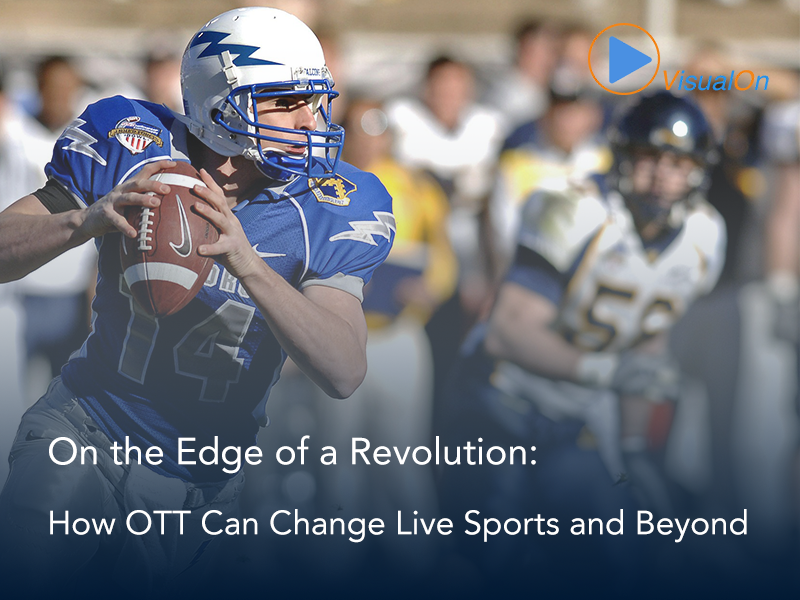On the Edge of a Revolution: How OTT Can Change Live Sports and Beyond

The first live streaming of sports was more than 80 years ago at the 1936 Olympics. Booths were set up allowing viewers to watch black and white, low resolution live streams of events. Contemporary reports stated that video quality was so low that most events were unwatchable. But this represented a milestone.
Over the intervening decades, the user experience improved for live sports – colorization, video quality and resolution were the most obvious ways. Also, cable and satellite TV allowed access to many different events and enabled new features. For instance picture in picture (PIP) allowed the simultaneous viewing of two streams and broadcast advanced allowed replays, on-screen graphics, close ups and the like.
The advent of OTT video brought two-way data to the live sports experience. Now, information for users and analytics for services to better monitor quality of service (QoS) is available, as well as target programming and advertising.
However, OTT also brought drawbacks to the live sports experience: latency, QoS issues like rebuffering and dropped frames and channel switching delays. Latency is generally considered the biggest issue – given the ubiquity of messaging and instant information, a 60-second delay is unacceptable to many viewers, especially on premium services.
Latency has improved over time. For example, Red Bee Media, Anevia and VisualOn demonstrated at NAB 2019, glass-to-glass latency of approximately 3.5 seconds in real-world conditions, where encoding occurred in Europe while viewing in the United States. However, this sort of scenario requires very tight coordination and optimization between the entire signal chain, close monitoring of network conditions and very accurate bitrate adaptation.
Low latency has also uncovered new issues. For example, open-source HTML5 players, such as Shaka and DASH.js, have inaccurate throughput measurement. This is not a serious issue for normal playback. But, when using fetch download in low latency situations, the throughput rule is too aggressive and the buffering rule is too conservative, causing bitrate adaptation oscillation resulting in re-buffering and other QoS issues. While these issues will likely be addressed by the open-source community, it serves as a reminder of the challenges of making “OTT as good as linear” for live streaming.
Mind-blowing OTT live video functionality
One key question then, is how can we move OTT ahead of the curve? Can technology be used to radically alter the live sports viewing experience from the traditional linear experience of one stream and one camera angle for the viewer at a given point of time? Enabling viewers to interrupt coverage for replays rather than when broadcasters choose.
The answer, of course, is yes. The strength of OTT is the flexibility between screens and a virtually unlimited number of streams.
This can allow the viewer to select camera angle and replays, even allowing multiple streams on one screen or shared between several. For example, a television can be split into four windows, each showing a different game or different camera angle. A smartphone can simultaneously be used to select instant replays or a breakdown and analysis of a play.
This promises to revolutionize the viewer experience in a very fundamental way. However, the technical challenges are significant and can only be accomplished through tight coordination and partnership through the entire ecosystem – hardware and software, from the broadcast booth to the client.
One of the most difficult challenges is synchronization of streams. If watching multiple games, the viewer does not want one to display a score or replay from another game before the main stream has broadcast that event Imagine a Red Sox fan watching a game against their rival Yankees, the bases are loaded and the pitcher is getting ready to start his windup. Another stream cuts away to the replay of a grand slam in Boston. That user experience is terrible.
Switching between camera angles in the same game requires even tighter synchronization between streams. The challenge is that the coordinated universal time or UTC clock on client devices is not always accurate and does now allow for the level of precision required. Coordination between the chipset manufacturer and the player provider can ensure that this feature can be properly implemented.
Live features beyond sports
While live sports is the primary target for these technologies, other live events can benefit too. Imagine a concert where a user could change camera angles to focus on individual musicians without the music being out-of-synch.
In addition to OTT being able to provide new experiences for live events, equally important is the opportunity to reach new viewers. According to International Telecommunication Union (ITU), in 2018, 85.3% of households in developed nations had internet access, compared to only 48.3% of those in developing nations. The “next billion” internet users will mostly come from developing nations and smartphones will be the gateway for most of them.
Addressing these new viewers brings additional challenges, due to often poor network infrastructure, low-end devices with limited capabilities, and new business models that reflect local economies. But the demand is there According to The Economist, mobile subscribers in India use an average of 8.8GB per month, nearly triple the data used by Americans and video is the overwhelming use case for data usage.
Addressing these viewers again requires partnerships and collaboration among the entire ecosystem. In this case, the challenges include minimizing bitrates to save bandwidth on given network and financial constraints. Meanwhile, techniques like post-processing can be used to enhance video quality for the screens and viewing conditions of users.
We, as an industry, have a chance to revolutionize the viewing experience of live streaming while providing access to billions of people, many of whom have never had the opportunity to experience live entertainment. Technology advances, new services and, most of all, cooperation between the entire signal chain is necessary to deliver on these promises.
Written by:
Michael Jones
SVP and Head of Business Development
Published by: OTT Video Executive Magazine




